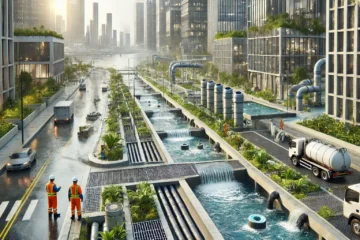Power Transmission and Distribution Networks in MEP Engineering
Introduction
Power transmission and distribution networks form the backbone of modern infrastructure, ensuring the reliable delivery of electricity from generation plants to end-users. In Mechanical, Electrical, and Plumbing (MEP) engineering, designing efficient and robust networks is critical to supporting the electrical demands of residential, commercial, and industrial projects. This blog explores the importance, components, and advancements in power transmission and distribution within the MEP field.
The Role of MEP Engineering in Power Systems
MEP engineering integrates electrical systems with mechanical and plumbing components to create energy-efficient, reliable, and sustainable environments. Power transmission and distribution networks designed by MEP engineers ensure:
- Uninterrupted power supply: Minimizing downtime and blackouts.
- Energy efficiency: Optimizing power usage and reducing losses.
- Safety compliance: Adhering to international and local codes.
- Scalability: Supporting future expansions in infrastructure.
Key Components of Power Transmission and Distribution Networks
1. Transmission Systems
Transmission systems transport high-voltage electricity over long distances from power generation plants to substations. Key elements include:
- Transmission Lines: Overhead or underground cables designed to handle high voltages.
- Transformers: Step-up transformers increase voltage for efficient long-distance transport, while step-down transformers decrease voltage for distribution.
- Substations: Critical nodes that regulate voltage, monitor grid performance, and manage power flow.
2. Distribution Systems
Distribution systems deliver electricity from substations to end-users, typically at lower voltages. Components include:
- Distribution Lines: Medium and low-voltage cables connected to local transformers.
- Service Drops: Final connections to homes or businesses.
- Switchgear: Equipment for controlling and protecting circuits.
Design Considerations in MEP Power Systems
1. Load Assessment
- Accurate calculation of peak and average power demands.
- Factoring in diversity and demand factors for various building types.
2. System Reliability
- Incorporating redundancy through looped or meshed distribution systems.
- Use of Uninterruptible Power Supplies (UPS) and backup generators.
3. Energy Efficiency
- Employing energy-efficient transformers and conductors.
- Minimizing transmission losses through high-voltage systems and optimized routes.
4. Safety Standards
- Designing systems in compliance with standards like the National Electrical Code (NEC) or IEC.
- Incorporating grounding, surge protection, and fault isolation mechanisms.
5. Integration with Renewable Energy
- Designing systems compatible with solar, wind, and hybrid power generation.
- Implementing grid-tied and off-grid solutions with smart inverters.
Challenges in Power Transmission and Distribution
- Transmission Losses
- High-voltage systems mitigate losses but require expensive infrastructure.
- Solutions include superconductors and power factor correction.
- Grid Reliability
- Natural disasters or equipment failures can cause outages.
- Smart grids and advanced monitoring systems help identify and resolve issues quickly.
- Integration of Renewable Energy
- Fluctuations in renewable energy sources can destabilize the grid.
- MEP engineers must design storage and load-balancing solutions.
- Urban Constraints
- Limited space for substations and underground cables in dense urban areas.
- Innovations like compact switchgear and multi-use utility tunnels address these challenges.
Advancements in Power Networks in MEP Engineering
1. Smart Grids
- Enable two-way communication between power providers and consumers.
- Features include automated fault detection, real-time monitoring, and dynamic load management.
2. Energy Storage Systems (ESS)
- Battery storage systems ensure stable power during peak loads or outages.
- Integration with renewable energy sources is becoming a standard practice.
3. Microgrids
- Localized power systems designed to operate independently or in conjunction with the main grid.
- Popular in campuses, hospitals, and remote industrial facilities.
4. Digital Twin Technology
- Virtual replicas of power systems enable predictive maintenance and efficient planning.
- Reduces downtime and ensures optimal performance.
5. Sustainable Practices
- Emphasis on energy-efficient designs and materials.
- Incorporating renewable energy sources directly into transmission and distribution systems.
Applications of Power Networks in Various Sectors
1. Residential Projects
- Load balancing for HVAC systems, lighting, and appliances.
- Integration of renewable energy like rooftop solar panels.
2. Commercial Buildings
- High demand for energy-efficient lighting, elevators, and HVAC systems.
- Smart building management systems for optimized energy use.
3. Industrial Facilities
- Support for high-capacity machinery and continuous processes.
- Designing fault-tolerant and scalable power networks.
4. Infrastructure Projects
- High-voltage systems for transportation networks like railways and metros.
- Renewable-powered grids for sustainable cities like NEOM in Saudi Arabia.
Future Trends in Power Transmission and Distribution
- Decentralized Energy Systems
- Increased adoption of local generation and storage solutions.
- Enhanced grid flexibility and resilience.
- AI and IoT Integration
- Predictive analytics for maintenance and fault prevention.
- Internet of Things (IoT) for real-time load and usage tracking.
- Green Power Initiatives
- Transition to zero-carbon grids by integrating large-scale renewable projects.
- Adoption of eco-friendly materials and practices.
- Dynamic Load Management
- Technologies to balance fluctuating demand with supply efficiently.
- Essential for electric vehicle charging networks.
Conclusion
Power transmission and distribution networks are vital for the success of modern MEP engineering projects. As energy demands grow and the world shifts toward sustainability, MEP engineers play a critical role in designing innovative and efficient systems. With advancements in smart grids, renewable integration, and sustainable practices, the future of power networks looks promising, ensuring reliability and efficiency for generations to come.


